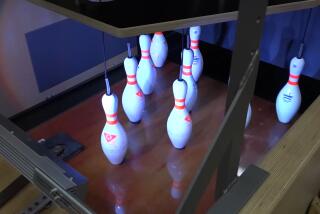Pin Collecting Grows to Olympic-Size Sport
- Share via
William Wu can attest to the lure of a stylish Olympic lapel pin.
The Irvine businessman recently exchanged a hard-to-find pin for a table in a crowded Atlanta restaurant, and he tells of pin collectors who have traded the decorative souvenirs for meals and airline seat upgrades.
“It’s amazing what you can get for one lousy pin,” said Wu, president of Aminco International Inc., an Irvine-based pin manufacturer.
There will be pins aplenty this month when a growing army of pin collectors marches on Atlanta to wheel and deal. Aminco and a handful of competitors are shipping an estimated 50 million pins--more than were manufactured for the last three Olympic Games combined.
Olympic officials now view pins as another licensing tool that can help generate funds to cover spiraling costs of staging the games, and corporate sponsors consider pins stylish marketing tools.
But the increasingly commercial nature of what once was a little-known hobby is prompting grumbling among longtime collectors who complain that prices for the rarest and most desirable pins will soar to Olympian heights, while huge production runs dilute the value of other pins.
Counterfeit pins can also wreak havoc on the market, and collectors ruefully acknowledge that there are no guarantees that a given pin will keep its value. Collectors still remember the 1984 Los Angeles Games, when a pin featuring Sam the Eagle, the Olympic mascot, clutching a soft drink rose to $300 before plummeting in price after several cheap imitations hit the market.
But Wu remains undaunted. He and at least two other pin manufacturers have each paid seven-figure licensing fees for the right to produce pins bearing Olympic symbols. The companies have also struck deals to produce pins for major corporate sponsors that have the rights to use Olympic logos.
Pins used to be relatively simple. Most featured the host city’s name, the date and an Olympic logo. But Aminco and a handful of competitors have turned pins into a minor art form, collectors say. The Irvine company has an eight-person art department that uses computers to craft new designs.
Although collectors pay attention to design details, it’s the limited-edition pins they truly crave. “We want the pins that are hardest to get,” Davis said. “For a true collector, the joy is in the hunt.”
Orange retiree Russell Davis, who has amassed more than 3,000 pins since a friend presented him with a colorful one during the 1984 Olympics, is especially proud of an FBI pin that’s one of only 550 copies produced: “There just aren’t many of them to go around, which is what makes them so valuable.”
Aminco contracts with domestic producers who manufacture some pins. But the overwhelming majority are air-freighted from a factory in China where 800 workers tackle the gritty, labor-intensive job of stamping and painting the pins.
Some dismiss pins as a fad that, like milk caps, will soon fade from the collectible scene. But Wu and a handful of competitors are betting that pins, driven by sports and corporate sales, will one day be as popular as sports trading cards.
“Pins are now a $250-million retail business,” said Brad Shuman, founder of a San Diego-based company that hopes to ship more than 20 million Olympic pins. “In two years, it will be a $500-million business and in a decade it will hit $1 billion.”
In Orange, Davis will soon be filling an attache case with “traders” and catching an airplane to Atlanta, where he’ll spend his free time looking for like-minded collectors.
“It could be on a street corner or in front of a store,” said Davis, a retired Treasury agent who will serve as a volunteer security official for the Games. “It could wind up being anywhere. But what you’ll find is a small army of collectors . . . and you won’t believe the frenzy that can be generated.”


